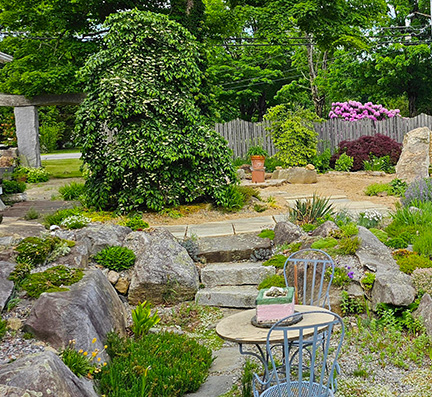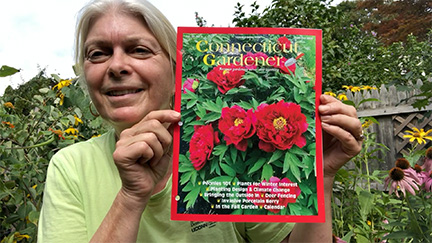By Elisabeth Zander
Rock gardening focuses on growing interesting plants from around the world in one’s garden. Yes, they are natives, from worldwide alpine peaks down to bogs, woodlands and deserts. Usually small in stature, the size of the plant depends on the scale of your garden.
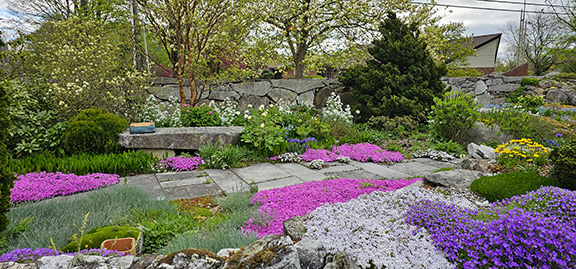
While it is a new art form in the long history of gardening, it gained popularity here in Connecticut during the last century in the 1940s. I became enchanted by it during the late 1980s, when I lived in Watertown.
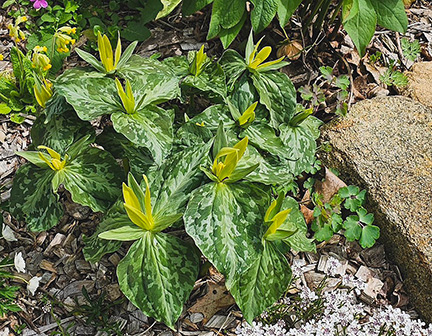
At that time my house had a north-facing grassy bank that was almost dangerous to mow. The slope was quite steep. Luckily for me I met members of the legendary Connecticut Chapter of the (then) American Rock Garden Society.
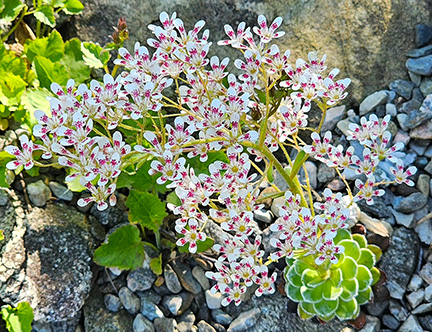
I was hooked by delights like Streptopus roseus from the forests of North America, as well as Sanguinaria canadensis ‘Multiplex,’ plus Enkianthus campanulatus from Japan. I began attending New Haven meetings, where there were inexpensive sales of plants of these specialties that were not often found in garden centers. These gardeners grew from seed!

As it turned out, the “dean” of American rock gardening, H. Lincoln (Linc) Foster, was among the members bringing plants to shows as well as the sales tables at our chapter meetings. And this eminent horticulturist had written the book, Rock Gardening in 1968.
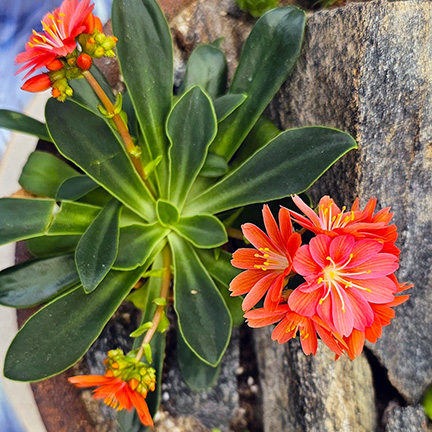
With my friend (who had a pickup truck), I began revamping that steep hillside with stones set as per directions in the book. And so my repertoire of plants increased to alpines, beginning with the easy ones: Arabis alpina, Aurinia saxatilis, Iberis sempervirens and Phlox subulata. Androsace sarmentosa ‘Chumbyi’ (rock jasmine), the plant Linc gave me as a thank you, still thrives today in my garden. Whenever I see its spring bloom, I remember this most gracious gardener.
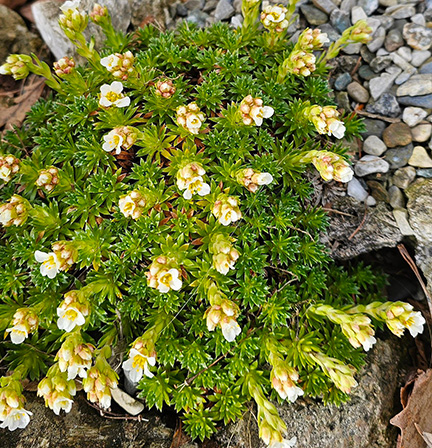
Sure, I kept my woodland native garden, but added the smaller perennial alpine plants into the rock bank in Watertown. Then in 2000, I moved up to the hills of Northwest Connecticut. There had been a garden 50 years prior, but trees had filled in, as well as invasives of bittersweet, bindweed and brambles. Oh and, of course, our native poison ivy. A challenge!
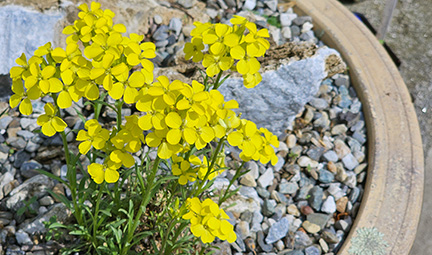
This allowed me to envision a blank canvas to create and try out each type of rock garden. I was still working in IT at the time, so it was the perfect respite to come home and rip out weeds. Over the years I have tried all the types of gardens described below. The following is a list, in alphabetical order.
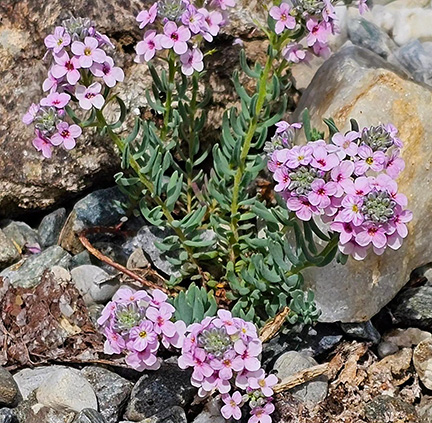
Alpine Berms
This was accomplished with “road sand” and some of the rocks lying around on the property. First we removed the top foot of weed infested grass and soil. Then we arranged rocks vertically in a couple of rows with bluestone pavers in between. Next, we filled the upright stones with sand. Road sand is available without salt and offers a nice mix from quarter inch down to fine grains. It is full of minerals which plants love. And it holds the moisture but won’t rot the plant crowns.
Plantings include the mounding Dianthus erinaceus which drapes the rocks, named forms of Daphne × hendersonii, overflowing Aubrieta canescens, the vibrant blue Gentiana acaulis, the airy Gypsophila repens, the shrubby low growing Deutzia gracilis ‘Nikko’, the ethereal purple Edraianthus serpyllifolius and various dwarf iris like Iris pumila.
Bog Gardens
The current garden is atop the Berkshire Hills, where stones drift to the surface every winter during frost heave. A sunken swimming pool turned out to be the answer to this dream. At the time of construction, a mix of half peat and road sand was dumped into the sunken pool. Of course, the sides were perforated before plunging to let excess water out. One planting was Arum italicum which is a native of the Mediterranean and the British Isles. The berries produced on tall stalks are eye catchers. Sarracenia, those indigenous pitcher plants off the East Coast, filled out the remainder of the plunged pool.
Container Gardens
This has been a fun type of garden that can also be movable. It works for
a condo garden or apartment terrace, too. Lately we have run workshops to up-cycle Styrofoam shipping containers into lightweight decorative troughs. It’s the perfect solution for growing hardy succulents like the showy cactus Gymnocalycium bruchii that resents our winter wet periods. In the same trough the feathery Townsendia montana var. caelilinensis complements the mounding spines. After fall, the container is moved to an outdoor porch.
Looking back, we started container gardening with fixed hypertufa troughs. These were imitations of stone animal water and feed troughs from farm days. But a lot more accessible as anyone might make them. They could be quite heavy, depending on size and fill. Usually, fill was crushed granite or limestone depending on plants to be grown. With the appropriate stone, a miniature garden of hostas and sempervivums is a standout for an entrance. The silver saxifrage are “good doers” and get that rich silver edging from the limey soil. And perfectly hardy.
Over the years we have collected old soapstone sinks. For the last five sinks, tufa was inserted to form crevice gardens for this old gardener. (So there is no bending on the knees in order to weed.) Tufa (calcareous lime) was stacked into the road sand soil on end. The difficult Kabschia saxifrages easily thrive with roots in tufa in the east facing sink. The tufa absorbs moisture and wicks it to the plant. The trick is to start cuttings directly in the stone. Then in late March we see a huge burst of bloom in various shades from red to pink to orange to yellow. My favorite is Saxifraga ‘Karel Čapek’, a beautiful pink. My favor is probably curried because of his book The Gardener’s Year, 1963. Funny it is to see people in plants. When Saxifraga ‘Joyce Carruthers’ blooms, I see my old friend who was so very kind but is now passed.
Crevice Gardens
This popular form of gardening came from the Czechs in the 1970s. In particular, from the work of Zdeněk Zvolánek, author of The Crevice Garden and its Plants, 2006, who has been on various tours here since the 1990s. He has constructed many crevice gardens across Europe and the Americas. During 2008, he visited this garden for a week. During that time he bonded with my husband, who happens to be a stone mason. With Zdeněk at the helm, they constructed a raised bed crevice garden that reminded me of an altar. (Good news, no kneeling to weed.) He perused the property and selected various flat granite stones. Rod, my spouse, borrowed a backhoe to move them in as Zdeněk placed them. The underfill was a layer of crushed inch-size granite. Then Zdeněk backfilled the structure with crushed granite called “processed,” that included stones of various sizes: ¾” down to dust.
At first the foreground was planted with Porophyllum (Kabscia) Section Saxifraga – those wonderful high alpine gems. They are like chocolates: hard to stop at just one. The “Valley of the Sax” continued for a decade, reliably flowering at early spring. At the top rim was room for a miniature evergreen collection. A particular favorite is a dwarf form of the Appalachian shrub Paxistima canbyi. Next to it, Androsace sarmentosa ‘Chumbyi’ intermingled with Gentiana acaulis. On the right-hand side, Primula allionii and its hybrids flowed from top to bottom in the open, like a Primula Theater. The crevices faced north, with a woods behind them. Unfortunately, for them, I wanted to grow more Turkish natives. Now these live in a different place.
We took down another two dozen trees for a different kind of crevice garden. We split a huge limestone boulder into pieces. And then pieced it back together with road sand in between. This proved to be the ultimate garden for the European Acantholimon trojanum, Astragalus angustifolius, Convolvulus suendermanii, as well as our American natives Opuntia humifusa (eastern prickly pear cactus) and Tetraneuris herbacea (lakeside daisy).
Raised Beds
This type of planting seemed to fit the bill when I was working full time an hour’s commute away from home. It was planted in 2003 in the old style, with a sloping rock perimeter around a sandy limestone bed. Rocks were placed flat on one another somewhat like a planted wall garden. But the design flared at one end to shape it like a teardrop. Natural travertine (hard tufa) stones, collected over the years from frost heave, were set on end in the sand. Moving scree plants like the Japanese Dicentra peregrina and European Papaver rhaeticum thrived. Asyneuma limonifolium and other stalwarts like Globularia repens and Eunomia oppositifolia flowered reliably each spring. My favorite turned out to be Edrainthus pumilio which made a wonderful purple bun, set off by the white limey sand.
Planted Walls
Free standing wall gardens emulate construction of a dry stone wall, but with a couple feet of soil in between. All stones face a common main direction and all stones tilt at the same angle. Like any sturdy retaining wall they slope inward at the top. They may be part of a freeform raised bed, with a flat growing area on top. Or just be a simple retaining wall. One tip I received was during construction to stuff sempervivums or sedums into places I wanted to put something a little more choice later on. They are easily removed to house Daphne arbuscula or Phlox borealis or Aubrieta deltoidea.
Woodland Rock Gardens
Natives of New England captured my heart when I moved here over 40 years ago. Stones abound here in the woods. And delicate ferns like Asplenium trichomanes ssp. trichomanes are right at home in my acid soil and granite rocks under shade trees. Trillium erectum is a tenacious native and often comes up in my woodchip paths. Aquilegia canadensis appears where it will. And what would spring be without Claytonia virginica? And these natives do not mind other woodland plantings of shrubs like Rhododendron viscosum, perennials like Glaucidium palmatum and easily edited annuals like Impatiens namchabarwensis.
Elisabeth served as president of the North American Rock Garden Society (nargs.org) and is now the society’s webmaster. Over the years, she has worked in many capacities for NARGS and the Berkshire Chapter of NARGS (berkshirechapternargs.org).

An avid gardener, she was sowing 1,400 packets of seed yearly by the late ’90s. She built raised berms, hill pocket, and shade gardens to house the plants and kept 2,500 species thriving. In 2000 she moved to a blank slate of property in the hills of northwest Connecticut. Since then, she and her husband Rod have built a greenhouse, stone walls, plunge beds, troughs, raised beds, sand beds, a bog garden, woodland gardens and extensive crevice gardens. She continues constructing additional outlays to her crevice and trough gardens.
